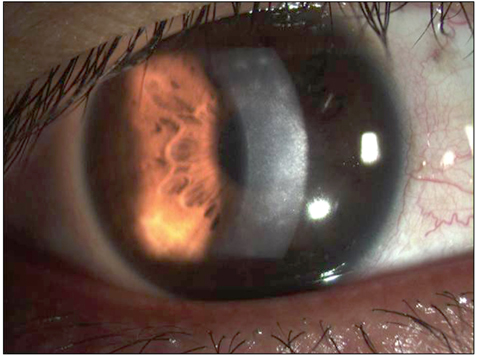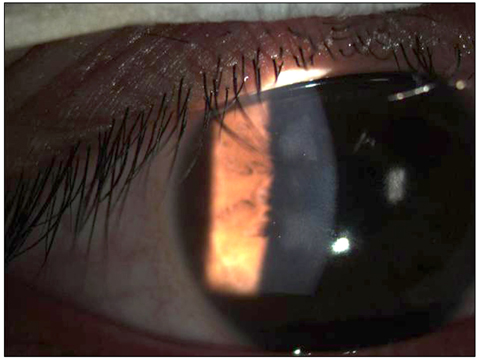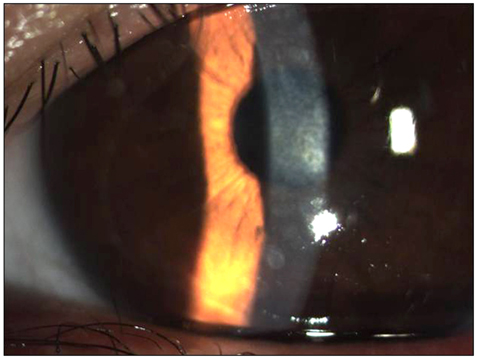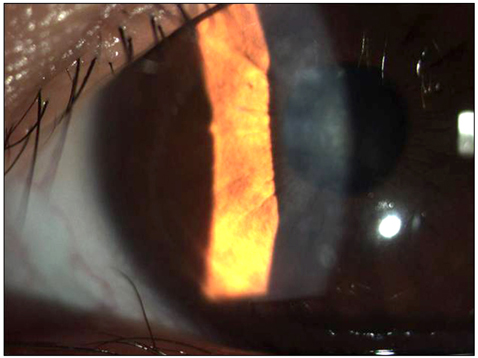Korean J Ophthalmol.
2011 Dec;25(6):443-446. 10.3341/kjo.2011.25.6.443.
Development of EKC after Eximer Laser Photorefractive Surgery and Subsequent Recurrence of EKC-like Keratitis
- Affiliations
-
- 1Department of Ophthalmology, Kim's Eye Hospital, Myung-Gok Eye Research Institute, Konyang University College of Medicine, Seoul, Korea. song@kimeye.com
- KMID: 1031193
- DOI: http://doi.org/10.3341/kjo.2011.25.6.443
Abstract
- This research focuses on four cases of patients having undergone eximer laser photorefractive surgery who were diagnosed with adenoviral keratoconjunctivitis during the postoperative period and who later developed epidemic keratoconjunctivitis (EKC)-like keratitis. Two of the patients had undergone laser-assisted subepithelial keratectomy (LASEK), one had undergone laser in situ keratomileusis and one had photorefractive keratectomy. After the surgery adenoviral keratoconjunctivitis and recurrent late-developing EKC-like keratitis were observed in the patients. Recurrent late-developing EKC-like keratitis occurred in one of the patients, who had received LASEK as many as three times. The others had only one or two episodes.The corneal infiltrates of keratitis mainly occurred in the central cornea. Successful resolution of recurrent late-developing EKC-like keratitis was achieved through the use of topical steroids without sequelae and the final best-corrected visual acuity was as good as the base line. These keratitis infiltrates have been presumed to represent an immune response to the suspected adenoviral antigens deposited in corneal stroma during the primary adenoviral infection. Previous reports argued that patients with a history of adenoviral ketatoconjunctivitis were succeptible to adenoviral keratoconjunctivitis becoming reactivated; however, in our research, our patients had their first adenoviral infections after the eximer laser photorefractive surgery and reactivation was confirmed. We recommend that attention be paid to adenoviral infection after laser refractive operations, because these patients seem to have more frequent recurrences.
Keyword
MeSH Terms
-
Adenovirus Infections, Human/diagnosis/drug therapy/*etiology
Adult
Conjunctivitis, Viral/diagnosis/drug therapy/*etiology
*Corneal Surgery, Laser
Eye Infections, Viral/diagnosis/drug therapy/*etiology
Female
Glucocorticoids/therapeutic use
Humans
Keratectomy, Subepithelial, Laser-Assisted
Keratitis/diagnosis/drug therapy/*etiology
Keratomileusis, Laser In Situ
Lasers, Excimer/therapeutic use
Photorefractive Keratectomy
*Postoperative Complications
Recurrence
Young Adult
Figure
Reference
-
1. Safak N, Bilgihan K, Gurelik G, et al. Reactivation of presumed adenoviral keratitis after laser in situ keratomileusis. J Cataract Refract Surg. 2002. 28:725–727.2. Jabbur NS, O'Brien TP. Recurrence of keratitis after excimer laser keratectomy. J Cataract Refract Surg. 2003. 29:198–201.3. Fite SW, Chodosh J. Photorefractive keratectomy for myopia in the setting of adenoviral subepithelial infiltrates. Am J Ophthalmol. 1998. 126:829–831.4. Campos M, Takahashi R, Tanaka H, et al. Inflammation-related scarring after photorefractive keratectomy. Cornea. 1998. 17:607–610.5. Pineda R, Talamo JH. Late onset of haze associated with viral keratoconjunctivitis following photorefractive keratectomy. J Refract Surg. 1998. 14:147–151.6. Marshall J, Trokel SL, Rothery S, Krueger RR. Long-term healing of the central cornea after photorefractive keratectomy using an excimer laser. Ophthalmology. 1988. 95:1411–1421.7. Meyer JC, Stulting RD, Thompson KP, Durrie DS. Late onset of corneal scar after excimer laser photorefractive keratectomy. Am J Ophthalmol. 1996. 121:529–539.8. Randleman JB, Hewitt SM, Stulting RD. Delayed reactivation of presumed adenoviral subepithelial infiltrates after laser in situ keratomileusis. Cornea. 2004. 23:302–305.9. Laibson PR, Dhiri S, Oconer J, Ortolan G. Corneal infiltrates in epidemic keratoconjunctivitis. Response to double-blind corticosteroid therapy. Arch Ophthalmol. 1970. 84:36–40.10. Romanowski EG, Pless P, Yates KA, Gordon YJ. Topical cyclosporine A inhibits subepithelial immune infiltrates but also promotes viral shedding in experimental adenovirus models. Cornea. 2005. 24:86–91.
- Full Text Links
- Actions
-
Cited
- CITED
-
- Close
- Share
- Similar articles
-
- Impact of Social Distancing and Personal Hygiene on the Prevalence of Epidemic Keratoconjunctivitis during the COVID-19 Pandemic
- Amblyopia and Strabismus by Monocular Corneal Opacity Following Suspected Epidemic Keratoconjunctivitis in Infancy
- Comparison of Refractive Outcomes of Broad Beam and Flying Spot Excimer Laser after Photorefractive Keratectomy
- Use of Topical Cyclosporin and Tacrolimus for Recurrent Subepithelial Infiltrates after Epidemic Keratoconjunctivitis
- Is the Eximer Laser Surgery on the Eyes Safe?





